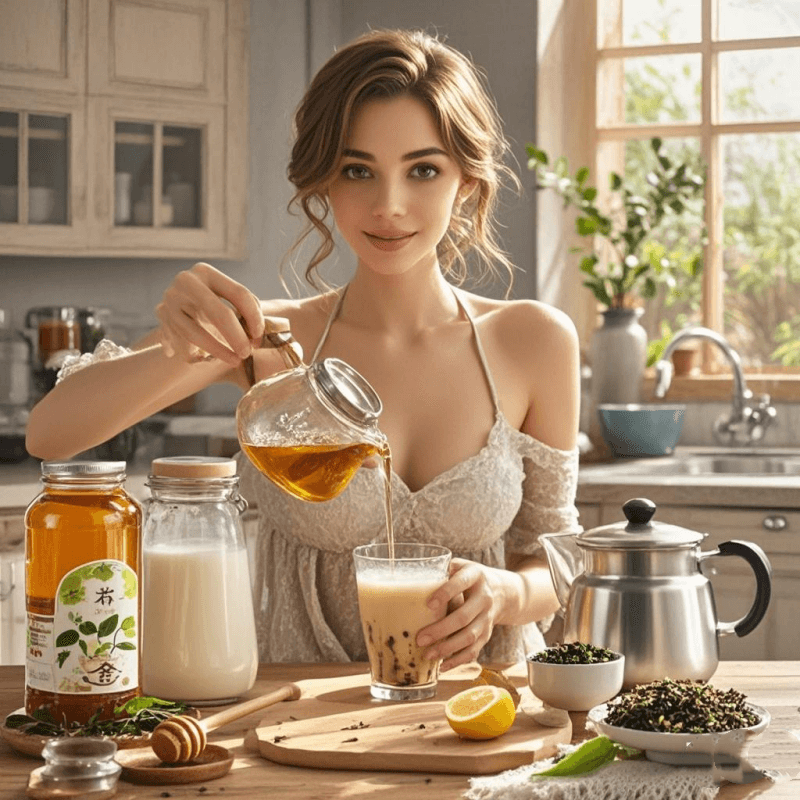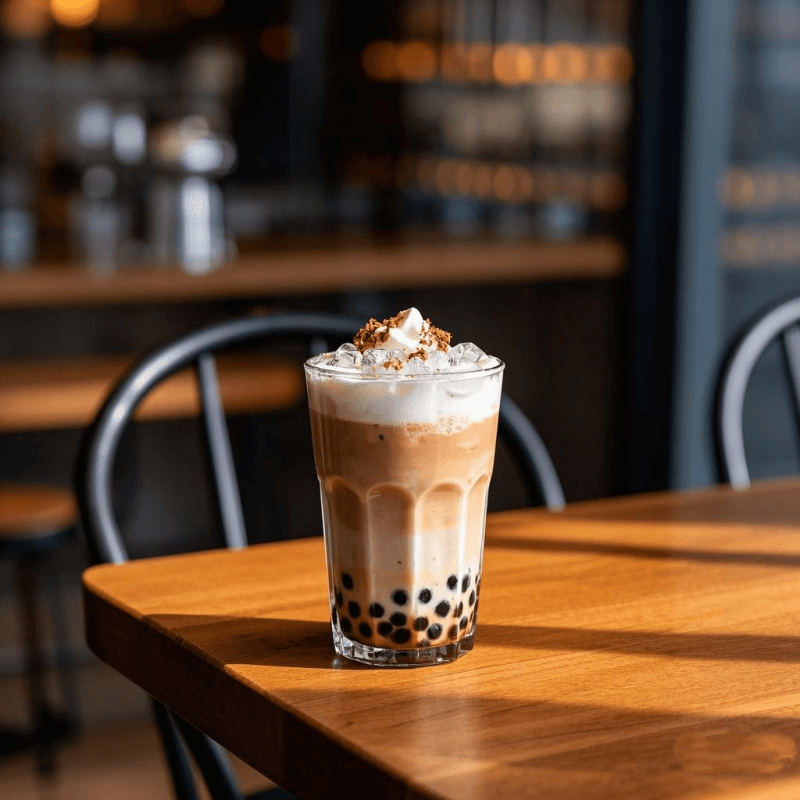In recent years, oolong milk tea has taken the beverage world by storm, captivating taste buds with its perfect harmony of rich tea depth and creamy sweetness. Unlike overly sweetened commercial drinks, homemade oolong milk tea lets you control flavors, sweetness, and texture—all with ingredients you likely already have. Whether you’re a tea enthusiast or new to the world of oolong, learning how to make oolong milk tea at home is a rewarding skill that brings café-quality sips to your kitchen. Let’s dive into why this beverage is beloved and how to craft it flawlessly.

Why Oolong Milk Tea Has Captured Tea Lovers’ Hearts
What makes oolong milk tea so special? It’s the balance. Oolong tea, with its diverse flavor profiles ranging from floral and fresh to toasty and rich, provides the perfect base for milk, which softens its astringency while enhancing its natural sweetness. Unlike green tea milk drinks that can taste grassy or black tea lattes that sometimes feel heavy, oolong milk tea strikes a middle ground—bright enough to stay interesting, creamy enough to feel indulgent.
Social media trends and café menus worldwide reflect its popularity, but there’s more to it than hype. Oolong tea brings subtle complexity that pairs beautifully with milk, creating a beverage that works for breakfast, afternoon pick-me-ups, or evening treats. Plus, making it at home lets you avoid additives and excess sugar, turning it into a healthier alternative to store-bought versions. It’s no wonder tea lovers keep coming back to this versatile drink—and why learning how to make oolong milk tea has become a must-have skill.
What Is Oolong Milk Tea? Breaking Down Its Flavor Fusion
At its core, oolong milk tea is a simple combination of oolong tea and milk, often sweetened to taste. But its magic lies in how these two elements interact. Oolong tea, known for its partial oxidation (between green and black teas), offers a spectrum of flavors: light oolongs like Tieguanyin bring floral, buttery notes, while darker varieties like Da Hong Pao offer roasted, caramel-like undertones. When paired with milk, these flavors transform—milk softens the tea’s edges, amplifies sweetness, and adds a velvety texture.
The result is a beverage that’s greater than the sum of its parts. Light oolong milk tea tends to taste fresh and floral, with milk adding creaminess without overpowering the tea’s delicacy. Darker oolong milk tea, on the other hand, becomes rich and comforting, with milk highlighting its roasted sweetness. This versatility means there’s an oolong milk tea for every palate, whether you prefer bright and refreshing or deep and cozy.
Discover the rich flavor of oolong milk tea with our curated leaves—our selection includes both light and dark varieties, letting you experiment with different flavor fusions at home.
How to Make Oolong Milk Tea with Simple Ingredients (Step-by-Step Guide)
Learning how to make oolong milk tea doesn’t require fancy equipment or hard-to-find ingredients. With just a few basics, you can craft a delicious version that rivals your favorite café. Here’s your step-by-step guide:
Ingredients You’ll Need:
- 2–3 teaspoons of loose-leaf oolong tea (adjust based on desired strength)
- 1 cup (240ml) water
- ½–¾ cup (120–180ml) milk of your choice (dairy, oat, almond, or soy work well)
- Sweetener (optional: honey, sugar, maple syrup, or brown sugar, to taste)
- Ice (if making iced oolong milk tea)
Step 1: Brew the Oolong Tea
Start by heating water to 185–205°F (85–96°C)—the exact temperature depends on your oolong:
- Light oolong: 185–195°F (85–90°C) to preserve floral notes
- Dark oolong: 200–205°F (93–96°C) to extract rich, roasted flavors
Place the oolong tea in a teapot or infuser, pour in hot water, and steep for 3–5 minutes. Avoid over-steeping, as this can make the tea bitter, which will overpower the milk later. Strain the leaves once done—you should have a fragrant, golden-brown tea base.
Step 2: Prepare the Milk
While the tea cools slightly (if making hot), warm your milk in a small saucepan over low heat until steaming but not boiling. Boiling milk can scorch it, creating an unpleasant taste. For iced oolong milk tea, chill the brewed tea and use cold milk instead.
Step 3: Combine and Sweeten
Pour the brewed oolong tea into a cup, then add the warm (or cold) milk. Start with a 1:1 tea-to-milk ratio, then adjust to taste—some prefer more tea for boldness, others more milk for creaminess. Add sweetener gradually, stirring until dissolved, and taste as you go. Remember, it’s easier to add more sweetness than to fix an overly sweet drink!
Step 4: Serve and Enjoy
For hot oolong milk tea, top with a sprinkle of cinnamon or a dash of vanilla (optional). For iced, fill a glass with ice, pour in the tea-milk mixture, and stir. That’s it—you’ve mastered the basics of how to make oolong milk tea!
Shop our selection of oolong teas perfect for milk tea recipes—our loose-leaf varieties are carefully chosen to complement milk, ensuring rich flavor in every cup.
Traditional vs. Modern Oolong Milk Tea Recipes

While the basic recipe is timeless, oolong milk tea has evolved with creative twists. Let’s compare traditional and modern approaches to inspire your next batch.
Traditional Oolong Milk Tea
Originating in Taiwan and China, traditional recipes focus on simplicity:
- Tea: Dark oolong varieties like Dong Ding or Wuyi oolong, steeped strong
- Milk: Fresh cow’s milk, sometimes from local farms
- Sweetener: Brown sugar or rock sugar, added sparingly to enhance natural sweetness
- Serving: Hot, in small cups, often enjoyed during tea ceremonies
This version emphasizes the tea’s natural character, with milk playing a supporting role rather than taking center stage.
Modern Oolong Milk Tea Innovations
Today’s tea lovers have embraced creative variations:
- Flavored Oolongs: Using jasmine or osmanthus-infused oolong for floral layers
- Plant Milks: Oat, coconut, or almond milk for dairy-free options (oat milk adds extra creaminess)
- Toppings: Boba (tapioca pearls), agar jelly, or grass jelly for texture
- Sweeteners: Honey, agave, or even salted caramel for unique twists
- Iced Versions: Blended with ice for slushy “oolong milk tea frappés”
These modern takes prove how versatile oolong milk tea is—whether you stick to tradition or experiment, the core pleasure of tea and milk harmony remains.
Pro Tips for Perfect Creamy Oolong Milk Tea Every Time
Learning how to make oolong milk tea is easy, but these pro tips will elevate your results from good to great:
- Choose the Right Oolong: Light oolongs pair best with delicate milks like almond or soy, while dark oolongs stand up to richer dairy or oat milk.
- Control Steeping Time: Over-steeping leads to bitterness. Set a timer—3–4 minutes for light oolongs, 5 minutes for darker varieties.
- Warm Milk Gently: Use a milk frother or double boiler for smooth, evenly heated milk without scorching.
- Balance Sweetness: Oolong tea has natural sweetness, so start with 1–2 teaspoons of sweetener per cup and adjust.
- Reuse Tea Leaves: Oolong leaves can be re-steeped 2–3 times—save the second steep for a milder milk tea.
Explore our teaware collection to brew oolong milk tea the right way—our traditional teapots and infusers help control steeping, ensuring perfect extraction every time.
Best Food Pairings for Oolong Milk Tea
Oolong milk tea’s balanced flavor makes it a versatile companion to many foods. Here are our top pairing recommendations:
- Sweet Treats: Buttery pastries (croissants, scones), shortbread cookies, or fruit tarts—the tea’s creaminess complements sweetness without clashing.
- Savory Snacks: Salted nuts, egg tarts, or light sandwiches (like cucumber or turkey)—the tea cuts through richness, refreshing the palate.
- Spicy Foods: Curries, stir-fries, or spicy noodles—the milk’s coolness balances heat, while the tea’s depth stands up to bold flavors.
- Breakfast: Pair with oatmeal, yogurt, or avocado toast for a satisfying start to the day.
Many tea lovers report that oolong milk tea aids digestion, making it a great post-meal drink too. As one home cook shared: “I make oolong milk tea after spicy dinners—it’s the perfect way to settle my stomach!”
Expert Insights: Why Oolong Tea Enhances Milk Tea
What makes oolong tea such a great base for milk tea? Its unique chemical composition plays a role. Oolong tea contains fewer tannins than black tea, which means less bitterness when combined with milk. At the same time, its natural oils and amino acids (like L-theanine) create a smooth texture that blends seamlessly with milk proteins.
Studies also show that oolong tea retains antioxidants even when mixed with milk, unlike some teas where milk may reduce certain benefits (learn more about tea and milk interactions here). This makes oolong milk tea not just delicious but potentially beneficial for metabolism and hydration.
For optimal flavor and benefits, choose high-quality loose-leaf oolong over tea bags. As tea expert Maria Uspenski notes: “Loose-leaf oolong releases more flavor and nutrients, creating a richer milk tea that’s worth the extra effort.”
How to Make Oolong Milk Tea: Troubleshooting Common Mistakes
Even experienced tea makers hit snags. Here’s how to fix common issues:
- Bitter Taste: Over-steeped tea or water that’s too hot. Next time, reduce steeping time or lower water temperature.
- Weak Flavor: Tea wasn’t steeped long enough, or the ratio has too much milk. Increase steep time or add less milk.
- Curdy Milk: Milk was too hot when added to tea. Let tea cool slightly before mixing, and avoid boiling milk.
- Too Sweet: Dilute with a splash more tea or milk, or serve over ice to mellow sweetness.
With a little practice, you’ll learn to adjust on the fly, perfecting your personal version of how to make oolong milk tea.
Conclusion: Embrace the Joy of Homemade Oolong Milk Tea
Learning how to make oolong milk tea isn’t just about following a recipe—it’s about connecting with a tradition of flavor while adding your own creativity. Whether you prefer classic hot oolong milk tea with dark oolong or a modern iced version with oat milk and boba, this beverage offers endless possibilities to explore.
The best part? It’s accessible to everyone. With simple ingredients, a little patience, and quality oolong tea, you can enjoy café-worthy sips at home anytime. So gather your supplies, experiment with ratios, and discover why oolong milk tea has become a favorite worldwide.
Learn the origins of oolong milk tea through authentic brewing tools—our collection includes traditional teapots and guides to help you honor this beverage’s heritage while making it your own.
In the end, the joy of oolong milk tea lies in its balance: of tea and milk, tradition and innovation, simplicity and complexity. Once you master how to make oolong milk tea, you’ll wonder how you ever lived without it.
